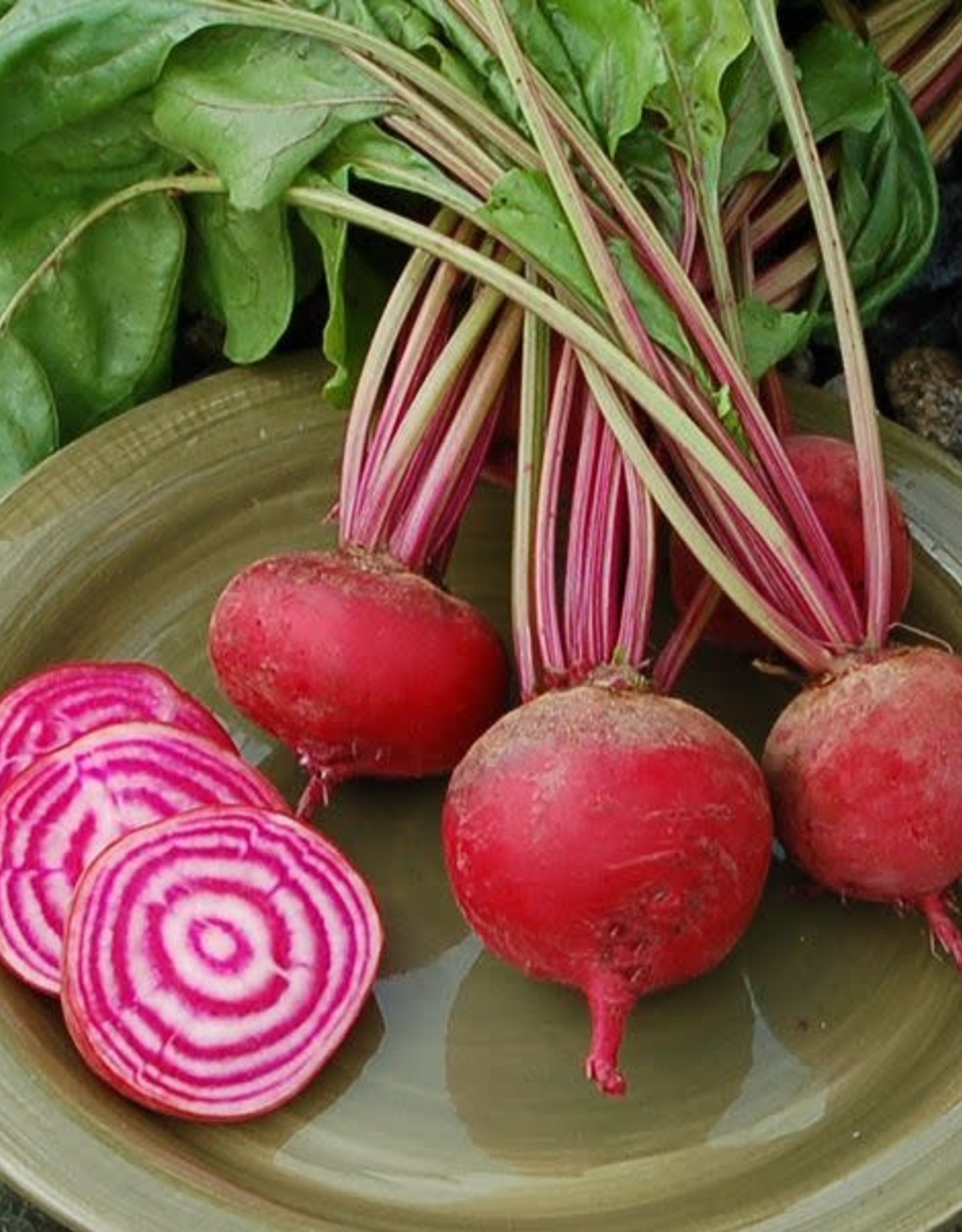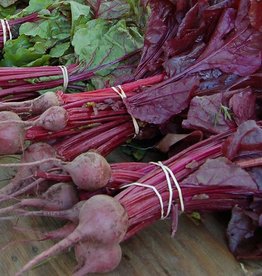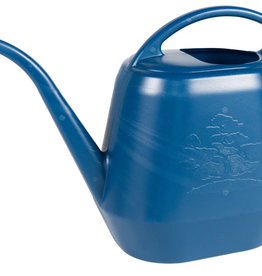HM Guardsmark Chioggia Beet 100 SEEDS
| Availability: | In stock (15) |
Photo and Description Credit - High Mowing Seeds
Unique and beautiful candy-striped beet.
Alternating rings of dark red and white make this variety a popular choice for specialty markets. A new strain of the popular Italian heirloom, improved by Alf Christianson Seed Company for better uniformity and bolt tolerance. Precision sized.
- Uniform
- Bolt tolerant
- 3" roots
1,250-1-875 seeds/oz (1,560 avg), 20,000- 30,000 seeds/lb (25,000avg)
Seeding Rate
Full Size Roots: ~300M seeds/acre (12lbs/acre) using 10 seeds/ft, 18” row spacing.
Babyleaf: ~ 20M seeds/100’ (~13oz/100’), 200M seeds/1000’ (~8lb/1000’) using 40 seeds/ft on 30” beds
Cultural Info
Beets (Beta vulgaris) are hardy biennials in the Chenopodiaceae family, which also includes spinach, chard, orach and quinoa.
- Garden Beets – From the deep red standard to striking gold, there is an abundance to choose from to please both the eye and the palate. Some are even specialized for edible leaves.
- Sugar Beets – With a sugar content of 20% and weighing from 8-15 pounds, this crop now generates close to half the world’s sugar.
- Forage Beets – Also called mangel beets, these are even larger than sugar beets and are used for animal feed.
Soil and Nutrient Requirements
Beets appreciate loose, well drained soils with acidity between 6.2 and 6.8, but they will tolerate 6.0-7.5 and a wide range of soil textures. Heavy clay soils can be helped by the addition of organic matter, but make sure it is well composted or it will increase the risk of scab. Best quality arises from deeply cultivated raised beds, free of stones and debris. Fertilize with the ratio of 1-2-2 (N-P-K) seven days before seeding. 1-3 side dressings may be necessary. Beets can suffer from internal black spot if boron levels are inadequate. Use 1lb of boron per acre.
Seeding Depth
½”-3/4”
Plant Spacing
Thin to 2-4” depending on desired size
Row Spacing
12-24"
When to Sow
Direct seed as soon as soil can be worked in the spring, or up to 6-8 weeks before fall frost. Optimal soil temperature for germination is 55-75°F.
Other Considerations
Fluctuations in the weather can cause white zoning in the roots.
Keep beets well weeded. Beets fighting for space become tough and stringy.
Too much nitrogen can cause a lot of leaf growth at the expense of root development.
Harvest
Harvest when roots reach desired size. For winter storage, allow crop to stand for a few mild frosts, but harvest before a hard freeze. For beet greens, harvest starting around five weeks, or when leaves are ~3”. Use floating row covers to extend season.
Storage
Optimal storage conditions for roots are 32°F and 95% humidity, cut tops at 1” above crown, wash and let dry. Roots store well for up to 6 months. For best storage of greens, cool with water immediately after harvest and refrigerate in a plastic bag to retain moisture.
Pest Info
- Leafhoppers are small wedge shaped insects suck the juice from leaves rather than eating holes through them. If leaves are yellowing and curling under, examine the underside for leafhoppers. They overwinter in the Louisiana area and arrive with storm fronts in other parts of the country.
- Flea beetles can present a problem, particularly for young plants, by chewing small holes in the leaves. Healthy plants usually outgrow the damage to produce a fine crop. Where undamaged leaves are desired or flea beetles are especially problematic, use floating row cover (see Supplies) from time of planting until two weeks after leaves emerge.
- Aphids can be washed off plants with a hard stream of water. They have several natural predators that control populations including parasites (aphids appear grey or bloated), lady beetle larvae and lacewings.
- Leafminers are generally controlled by natural predators. Deep plowing in the spring can help, as well as controlling alternate hosts such as lambsquarter, chickweed, nightshade and plantain.
- Cabbage Maggot can infect transplants and young seedlings as they feed on roots, use nematodes to alleviate transplant damage in trays.
Disease Info
- Leaf spots are commonly caused by either Cercospora beticola or Phoma batae and are most prevalent in mid-late summer, during periods of frequent rainfall and high humidity.
- Pocket Rot is caused by the fungus Rhizoctonia solani and is spread plant to plant, creating pockets of infected plants. Damping off and root rots are caused by a number of individual fungi.
- Downy Mildew, Pernospora sparsa, may appear in mid-to late summer. There are no resistant beet varieties available for these diseases. Prevention includes removal of plant debris, crop rotation (preferably with grains), and increased air circulation.
- Scab is caused by the bacteria Streptomyces scabies and is most severe under dry conditions and high pH soils which result in boron deficiencies. Prevention includes rotation of susceptible crop types (potato, radishes, carrots, turnips, rutabagas, parsnips), a soil pH below 5.5 and moist conditions in early tuber development.





